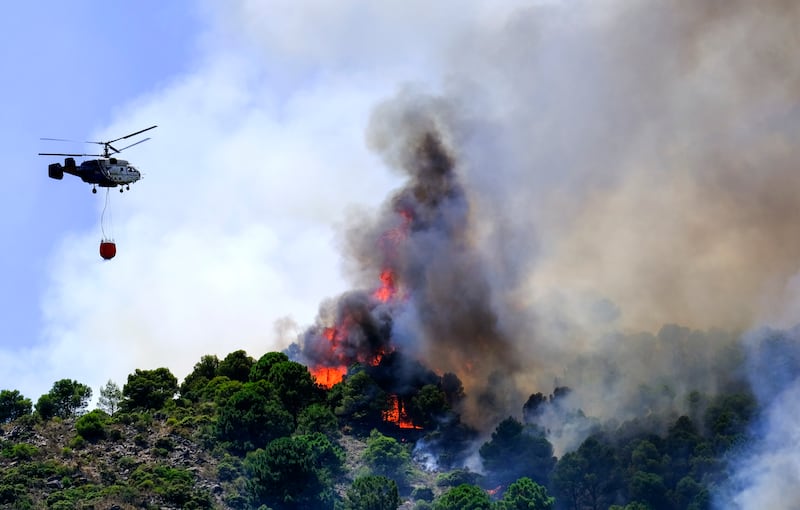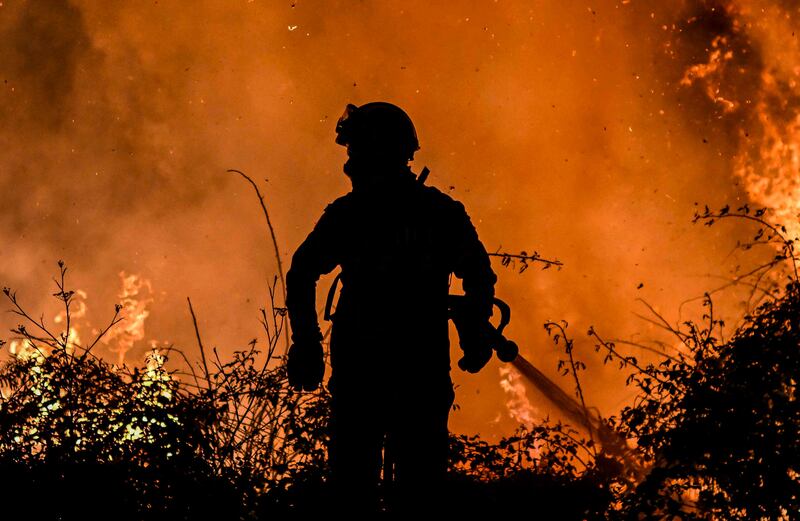A heatwave sweeping southern Europe that has caused hundreds of deaths and huge wildfires in past weeks showed some signs of abating on Monday but continued to move north, including towards Britain where authorities issued an extreme weather warning.
Wales recorded its hottest day on record, the UK Met Office said, as temperatures reached 35.3C degrees in Gogerddan, near Aberystwyth, exceeding the previous record high of 35.2 degrees, recorded at Hawarden Bridge, Flintshire on August 2nd, 1990.
In southern England, temperatures exceeded 37 degrees in a number of locations including Cambridge and Heathrow Airport in London. The extreme temperatures forced some hospitals in England to cancel surgery because operating theatres were too hot. The Met Office warned there was an outside chance of temperatures rising to 43 degrees on Tuesday.
Much of Europe is baking in a heatwave that scientists say is consistent with climate change and has pushed temperatures into the mid-40s in some regions, with wildfires raging across tinder-dry countryside in Portugal, Spain and France.
READ MORE
Temperatures in some parts of southern Europe began to ease over the weekend but thousands of firefighters across the region still battled to contain hundreds of wildfires and authorities said the risk of further blazes remained extremely high.
Spain was facing the eighth and last day of a more than week-long heatwave on Monday, which caused more than 510 heat-related deaths, according to estimates from the Carlos III Health Institute.
With fires burning thousands of hectares in Galicia, Castille and Leon, Catalonia, Extremadura and Andalucía, Spain mourned the death of one firefighter in the northwestern province of Zamora on Sunday evening. Almost the entire country faces an extreme fire risk.
[ Dublin Airport records all-time highest temperatureOpens in new window ]
[ How to protect yourself as continental heatwave hits IrelandOpens in new window ]
[ Q&A: Why are temperatures so high across Europe?Opens in new window ]
“There are never words to thank the immense work of those who fight the fires tirelessly,” prime minister Pedro Sanchez said on Sunday night in a condolence message on Twitter.
More than 70,000 hectares (173,000 acres) have burnt in Spain so far this year, the worst year of the last decade, according to official data. Last month, a huge wildfire in Sierra de la Culebra, Castille and Leon, ravaged about 30,000 hectares of land.
Spain also reported a second death caused by a wildfire after a fireman died on Sunday. A 69-year-old was found dead on Monday in Ferreruela, in an area burned by flames, emergency authorities said. Local media said it was a farmer.
In Portugal, temperatures dropped over the weekend, but the risk of wildfires remained very high across most of the country, according to the Portuguese Institute of Meteorology (IPMA).
More than 1,000 firefighters, backed by 285 vehicles and 14 aircraft, were battling nine wildfires, mainly in the country’s northern regions, authorities said.
Belgium and Germany were among the countries expecting the heatwave to hit them in coming days.
Britain was on course for its hottest day on record on Monday with temperatures forecast to hit 40 degrees for the first time, forcing train companies to cancel services, schools to close early and ministers to urge the public to stay at home.
The government has triggered a “national emergency” alert as temperatures were forecast to surpass the 38.7 degrees recorded in the Cambridge University Botanic Garden in 2019 on Monday and Tuesday.
“We hoped we wouldn’t get to this situation but for the first time ever we are forecasting greater than 40 degrees in the UK,” climate attribution scientist at the Met Office, Dr Nikos Christidis, said.

“Climate change has already influenced the likelihood of temperature extremes in the UK. The chances of seeing 40 degrees days in the UK could be as much as 10 times more likely in the current climate than under a natural climate unaffected by human influence,” he said.
In France, wildfires had spread over 11,000 hectares (27,000 acres) in the southwestern region of Gironde, and more than 14,000 people have been evacuated, regional authorities said on Sunday afternoon.
More than 1,200 firefighters were trying to control the blazes, the authorities said in a statement.
France issued red alerts, the highest possible, for several regions, with residents urged “to be extremely vigilant”.
In France in the Landes forest, in the southwest Aquitaine region, temperatures would be above 42 degrees, said forecaster Olivier Proust.
And Brittany, which until recently has escaped the worst of the heat, could register temperatures as high as 40 degrees which would be a record for the region.
By late Sunday, the fires in Gironde, which have been raging since Tuesday, had already destroyed 13,000 hectares (32,000 acres), driven by high winds and forcing the evacuation of 16,200 holidaymakers, fire service officials said.
The blaze at the Teste-de-Buch forest in south-western France had arrived at the beach and was moving south, the local prefecture said. Video shot by people at the scene showed the large fire consuming the beach at La Lagune, near the famous Dune of Pilat — Europe’s tallest sand dune.
France’s interior ministry announced it was sending three more firefighting aircraft to reinforce the six already operating in the region, as well as 200 more firefighters and more equipment.

But the crews fighting the blaze will have to contend with soaring temperatures on Monday. It is one of the regions on a “red alert” heatwave warning.
“In certain zones in the southwest, it will be an apocalypse of heat,” forecaster Francois Gourand of Meteo-France said.
Temperatures across France are expected to be over 30C (86F) but between 38 and 40 degrees in the western half of the country.
Officials in several regions, meanwhile, have also issued pollution alerts because of the high concentrations of ozone.
In Italy, where smaller fires have blazed in recent days, forecasters expect temperatures above 40 degrees in several regions in coming days.
Switzerland also suffered the effects of the heatwave. Axpo, the operator of the Beznau nuclear plant, said it on Monday it was forced to reduce output so that it does not overheat the Aare river from which it draws its cooling water. – Reuters/Guardian












